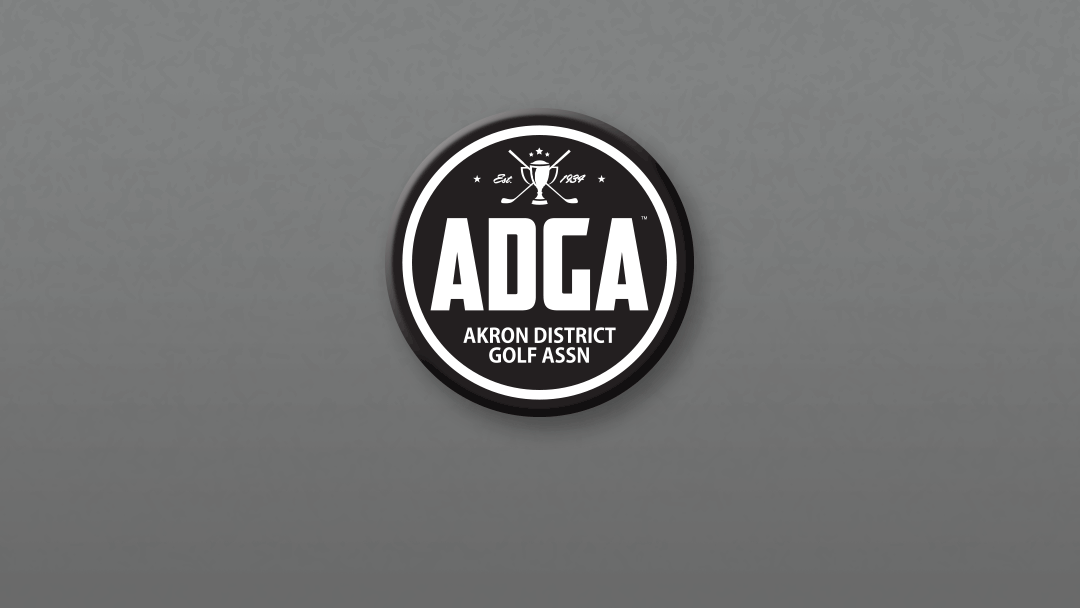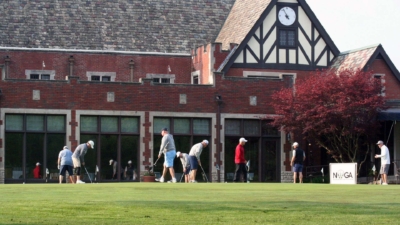 The Akron District Golf Association abides by the Rules of Golf as set forth by the United States Golf Association; players should review the Rules of Golf and the Decisions on the Rules of Golf for questions that arise during competition.
The Akron District Golf Association abides by the Rules of Golf as set forth by the United States Golf Association; players should review the Rules of Golf and the Decisions on the Rules of Golf for questions that arise during competition.
The following items are the Local Rules and the Conditions of Competition as determined by the ADGA to administer the league, its events, and the Golfer of the Year tournament and standings:
DIVISIONS:
Unless stated otherwise, the ADGA runs each event in two divisions: Championship and Senior.
The Championship Division is the open division, and players of any age may compete in that division.
The Senior Division is for players age 50 and over. A player must turn age 50 before the first event of the season to be eligible for the Senior Division, and must indicate a choice for that division.
If a Senior player competes with a Championship division player in a team event in the Championship division, any points earned by the Senior in that Championship event will apply to his Senior Division standings for Golfer of the Year.
A player must choose a division for GOY points at the start of the season. Because different tee locations are used for each division, a player cannot compete in both divisions at once.
TEE POSITIONS:
Championship Division: longest, championship ‘gold’ tees
Senior Division: standard, middle-distance ‘white’ tees
NON-CONFORMING GROOVES RULE
The ADGA will NOT adopt as a condition of competition the USGA rule 4-1/1 with an effective date of January 14, 2014. While we support the USGA and its rules authority, the committee feels that all ADGA competitor’s should be afforded ample time to make the necessary changes in their equipment if they can, and will not impose any penalties during competition.
SUMMER GOLF
The ADGA’s default Condition of Competition. Commonly known as ‘play it as it lies’ or ‘play the ball down’.
PREFERRED LIES OR WINTER RULES
Adverse conditions, including the poor condition of the course or the existence of mud, are sometimes so general, particularly during winter months that the Committee may decide to grant relief by temporary Local Rule either to protect the course or to promote fair and pleasant play. The Local Rule should be withdrawn as soon as the conditions warrant.
IN YOUR OWN FAIRWAY ONLY, a player may mark a ball, lift, clean and replace it to the position as marked by the player. A ball in play under “Preferred Lies” may be moved with the club head as well. The ball must be returned to a spot no more than six inches (6″) from its original location.
ONE BALL RULE
The ‘one ball rule’ is in effect for ADGA events. During a stipulated round, the balls a player plays must be of the same brand and model as detailed by a single entry on the current List of Conforming Golf Balls. If a ball of a different brand and/or model is dropped or placed, it may be lifted, without penalty, and the player must then proceed by dropping or placing a proper ball (Rule 20-6).
DISTANCE MEASURING DEVICES:
Distance-measuring devices (DMD) or ‘range finders’ are permitted through a Local Rule, provided the device only measures distance. A multi-functional device must be set to ‘distance only’ or is in breach. Distance information obtained by a player from a device may be shared with fellow competitors to speed up play, without penalty.
GROUND UNDER REPAIR:
Ground under repair” is any part of the course so marked by order of the Committee or so declared by its authorized representative. All ground and any grass, bush, tree or other growing thing within the ground under repair are part of the ground under repair. Ground under repair includes material piled for removal and a hole made by a greens keeper, even if not so marked. Grass cuttings and other material left on the course that have been abandoned and are not intended to be removed are not ground under repair unless so marked. If the original ball is found outside the water hazard, the player must continue play with it.
COURSE CONDITIONS:
For issues due to mud, extreme wetness, poor conditions and protection of the golf course.
Relief for Embedded Ball – Through the green, a ball that is embedded in its own pitch-mark in the ground may be lifted, without penalty, cleaned and dropped as near as possible to where it lay but not nearer the hole. The ball when dropped must first strike a part of the course through the green.
Aeration Holes – Through the green, a ball that comes to rest in or on an aeration hole may be lifted without penalty, cleaned and dropped as near as possible to the spot where it lay but not nearer the hole. The ball when dropped must first strike a part of the course through the green.
Stones in Bunkers – Stones are, by definition, loose impediments and, when a player’s ball is in a hazard, a stone lying in or touching the hazard may not be touched or moved (Rule 13-4).
DECIDING TIES:
For individual stroke play events, ties will be broken by an extra hole ‘sudden death’ playoff. For team events, ties will split prizes.
SCORE CARDS AND SCORING:
Each player is responsible for returning their scorecard upon completion of play. Each scorecard must be signed by the player and the marker. All players in a foursome must return their scorecards to the scoring area together to prevent any scoring errors. Any questions regarding the Rules must be resolved at the scoring table with ADGA officials.
TIME OF STARTING:
Rule 6-3A is amended to provide that the penalty for starting late, but within fifteen minutes of the starting time, is reduced from disqualification to loss of the first hole in match play or two strokes at the first hole in stroke play. Previously this penalty reduction could be introduced as a condition of competition.
STARTING TIMES:
If a player contacts the ADGA more than 30 minutes prior to their starting time with an emergency or a delay beyond personal control, the ADGA will adjust the player’s starting time (within reason).
COMMITTEE DECISIONS:
RULE 34-3, in the absence of a referee, any dispute or doubtful point on the Rules must be referred to the Committee, whose decision is final. If the Committee cannot come to a decision, it may refer the dispute or doubtful point to the Rules of Golf Committee of the USGA, or the Head PGA professional on site whose decision is final.


































